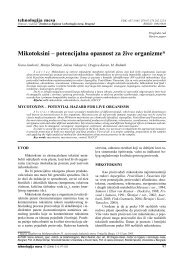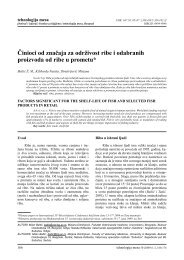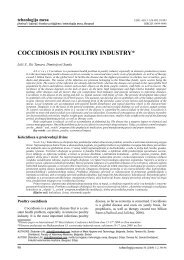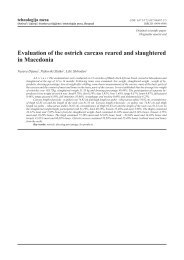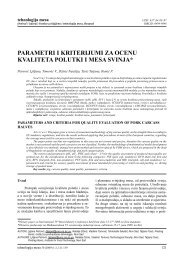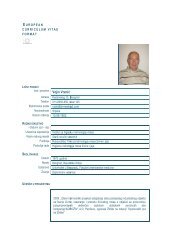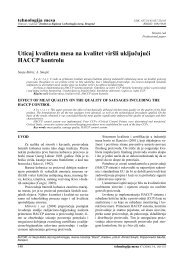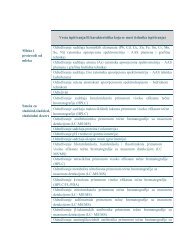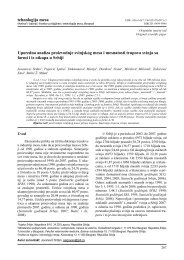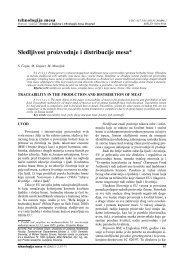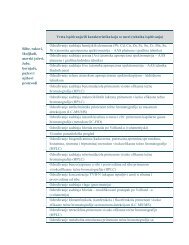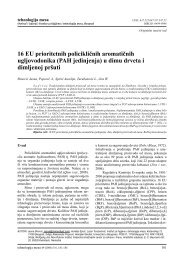Najnoviji broj Äasopisa - inmesbgd.com
Najnoviji broj Äasopisa - inmesbgd.com
Najnoviji broj Äasopisa - inmesbgd.com
Create successful ePaper yourself
Turn your PDF publications into a flip-book with our unique Google optimized e-Paper software.
Tehnologija mesa 53 (2012) 2, 140–147<br />
Rašeta J., 1958. Ispitivanje procesa zrenja u sremskoj kobasici.<br />
Izvod iz doktorske disertacije. Acta Veterinaria, 8, 1,<br />
78–95.<br />
Skok P., 1971–1974. Etimologijski rječnik hrvatskoga ili srpskoga<br />
jezika. I–IV, JAZU, Zagreb.<br />
Tarladgis B. G., Pearson A. M., Dugan L. R., 1964. Chemistry<br />
of the 2-thibarbituric acid test for determination oxidative<br />
rancidity in foods. II Formation of the TBA malonaldehyde<br />
<strong>com</strong>plex without acid-heat treatment. Journal of<br />
the Science of Food and Agriculture 15, 602.<br />
Vuković I., Bunčić O., Babić LJ., Radetić P., Bunčić S., 1988.<br />
Ispitivanje važnijih fizičkih, hemijskih i bioloških promena<br />
u toku zrenja kulena. Tehnologija mesa, 34, 2, 34–39.<br />
Vuković I., Vasilev D., Saičić S., Bunčić O., 2004. Mikroflora i<br />
fizičko-hemijski pokazatelji kvaliteta kulena. Tehnologija<br />
mesa, 45, 3–4, 104–107.<br />
Vukovic I., Saičić S., Vasilev D., 2011a. Contribution to<br />
knowledge of major quality parameters of traditional (domestic)<br />
kulen. Tehnologija mesa, 52, 1, 134–139.<br />
Vuković I., Petrović Lj., Vasilev D., Saičić S., 2011b. Mikroflora<br />
und Qualität von nach traditionellem Verfahren herrgestellten<br />
Rowürsten aus Nordserbien. Fleischwirtschaft,<br />
91, 11, 118–122.<br />
Vuković I., 2012. Osnove tehnologije mesa, 4. izdanje, Veterinarska<br />
komora Srbije, Beograd, s. 294.<br />
Investigation of major changes during ripening of<br />
traditional fermented sausage Lemeški kulen<br />
Vuković Ilija, Vasilev Dragan, Saičić Snežana, Ivanković Stipan<br />
S u m m a r y: In this paper the results of investigation of major changes during ripening of traditional fermented dry sausage<br />
Lemeški kulen are presented. During the ripening of Lemeški kulen microfl ora is growing very slowly, what is typical for natural ripening<br />
of fermented sausages in the winter. In microfl ora of Lemeški kulen lactobacilli are dominant; they ferment sugar from paprika to<br />
lactic acid. During sausage ripening the number of micrococci and enterococci decreased, while Pseudomonadaceae and Enterobacteriaceae<br />
died out. At the end of the fi rst ripening phase, which lasted three months at low temperatures, a w value was 0,90 and pH value<br />
5,3 and product reached bacteriological stability. At the end of the ripening process a w value decreased to 0,86 and pH value increased<br />
up to 5,5. Lemeški kulen contained less than 30% water, more than 30% meat proteins and fats, and the percentage of the collagen<br />
content in total meat proteins was 6,0 %. The fat protein content ratio was about 1,0 and the moisture-meat protein content ratio was<br />
below 1,0 (0,85). Although nitrate was not used, it was detected in the kulen; where nitrate originated from paprika. During the ripening<br />
of Lemeški kulen, acid value increased by about ten times, but peroxide number and TBARS-value (Thiobarbituric Acid Reactive<br />
Substances) remained unchanged. Sweet and hot domestic paprika from Lemeš area, added in amount of 3%, is very important for the<br />
quality of Lemeški kulen, because paprika has an antioxidative effect and also influences the colour, fl avour and texture of sausage.<br />
Key words: Lemeški kulen, microfl ora, <strong>com</strong>position, quality.<br />
Rad primljen: 20.11.2012.<br />
Rad prihvaćen: 22.11.2012.<br />
147



